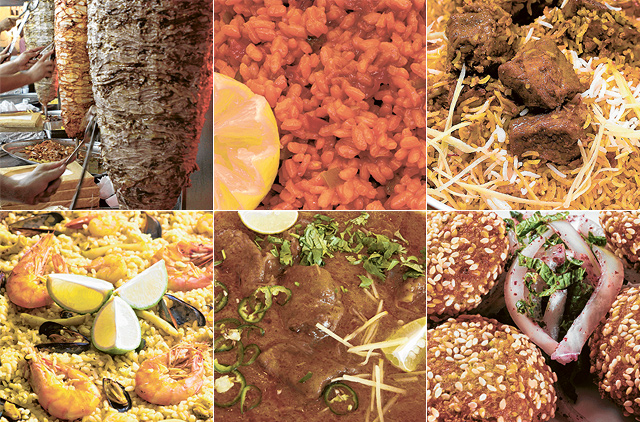Dubai: French fries and falafel — neither has anything to do with either France or the Arab world. The potato dish is originally from Belgium while the lentil patty can be traced to India and Pharaonic Egypt. Makes you wonder — do you really know your food?
This question led us to trace the origins of 16 popular foods found in the UAE. What we discovered was surprising and definitely offered a glimpse of how different cultures have influenced each other.
While jalebis, a fried sweet soaked in sugar syrup, is ubiquitous to northern India — it is also consumed in Iran and known as zaalebi. Did Iranian travellers bring it to the subcontinent or was it the other way around?
Food is a maze of global cultural migration and each of us is a piece of that puzzle — together it is our collective consumable history.
And one thing is for sure ... curry is not a British invention, as some would like to believe but traces its roots to ancient Iraq. All patents pending — Mesopotamia.
Shawarma
Doner kebabs, a Turkish word that literally means "turning roast", originated from Turkey. This nomadic dish was created due to its ease of transport and had a long life. The dish was cooked on a vertical spit and sliced off before being served. The Arabian shawarma gives credit to these doner kebabs. The name shawarma comes from the Turkish word "cevirme". As it moved to the Arab world many changes to its preparations were made — the slivers of chicken or meat are wrapped in pita bread with garlic paste, pickles, tomatoes and a lot of lettuce.
Main source: www.divandonner.co.uk
Spanish Rice
Spanish rice, also known as Mexican rice, is a side dish made from white rice, tomatoes, garlic, onions, parsley, cilantro. The Moors invaded Spain in the year 711. They were heavily influenced by the cuisine and culture of Arabs from the Middle East. It is believed that the Moors were the ones who introduced the concept of Spanish rice. By the time the Moors left, Spanish rice was part of Spain's culture and they were not going to let it go. The fact that the origins of Spanish rice date back to the Moors is also supported by linguistic evidence. The Spanish word for rice is "arroz", which comes from the Arabic name for rice "Al ruzz".
Main source: www.kwintessential.co.uk
Pie
The all-American pie is in fact not American. It is said that the concept of pies originated as early as ancient Egypt. The Egyptians used to use nuts, honey and fruits in bread dough. It is believed that between 1400 BC and 600 BC the recipe was passed down to the Greeks. It was then adopted by the Romans, 500 years later, who in-turn spread it throughout Europe as they advanced and conquered the countries. Each country developed its own recipe for pie. The dish came to the US with the English settlers. The early American pie crusts, like the Roman pies, were not intended for consumption as they were only designed to hold the filling while baking.
Main source: American Pie Council (APC)
Pizza
Pizza and Italy go hand in hand, but the pizza actually originated from Greece. Ancient Greeks and Romans had a type of bread without yeast, topped with different items before being baked — Greek pizzas only had vegetables. This idea of the flat bread found its way to Italy in the 18th century. During her inspection tour in 1889, Italian Queen Margherita noticed many of the people eating these flat breads so she decided to try one. She loved them so much that she ordered chef Rafaelle Esposito from his pizzeria to the royal palace to bake a selection of pizzas for her. To honour the Queen the chef added tomatoes, mozzarella cheese and fresh basil to the pizza to represent the Italian flag. The pizza's popularity increased due to the Queen's love for them.
Main source: www.inmamaskitchen.com
Paella
During the centuries following the establishment of rice in Spain by the Moors of Arab origin, the peasants of Valencia would cook the rice on a flat pan, the Latin word for it is patella. The Moorish kings' servants created these dishes by mixing the leftovers from royal banquets with rice in large pots to take home. Some say that the word "paella" originates from the Arabic word "baqiyah", which means leftovers.
Main source: www.thepaellacompany.co.uk
Hamburger
The concept of a hamburger originated from Hamburg, Germany, between the 18th and 19th century. The Hamburg beef was salted and sometimes smoked. This made it ideal for long journeys. Since the meat was hard, it was minced and sometimes stretched and mixed with breadcrumbs and chopped onions. Immigrants, who settled in the US in the 1850s, continued to make this recipe, which soon became a popular American dish.
Main source: www.whatscookingamerica.net
Hot Dog
The earliest reference to the word sausage appeared in Homer's Odyssey — an ancient Greek tale of adventure and heroism — in 850 BC, which said: "As when a man besides a great fire has filled a sausage with fat and blood …"
One of America's favourite foods, the hot dog, started with a man called Johann Georghehner. In the late 17th century, the butcher, living in Coburg, Germany, invented the "dachshund", or "little-dog", sausage. He then travelled to Frankfurt to promote his new product. The hot dog was introduced in the US in 1893. During that year, the Colombian Exposition brought many visitors to Chicago who consumed a lot of sausages sold by vendors. It became popular because it was easy to eat and inexpensive. Germans always ate the dachshund sausages with bread, which is similar to the hot dog sandwich.
Main source: www.hot-dog.org
Doughnut
When doughnuts come to mind, some people say "Dunkin Donuts" or Homer Simpson. The origins of this sweet and fattening circular bread dates back to the 19th century. It is believed that Holland and Germany used to drop any extra dough into boiling oil to make fry-cakes. But Holland decided to step it up a notch and shape these pieces of dough into knots and covered them in sugar. The ring shape came later when famous Dutch sea Captain Hansen Crockett Gregory, dissatisfied with the soggy centre of the doughnut, used to poke a hole in the middle. The Dutch are believed to have introduced the doughnut to the US.
Main source: www.foodtimeline.org
Fish and Chips
The English pride and joy dish is not completely English. The chips, which come from Belgium, was never an addition to fish, but was a substitute. When rivers froze and fishing was not an option, housewives used to cut potatoes in the shape of a fish and fry them as an alternative. During the same time, fried fish was introduced to Britain by Jewish refugees from Portugal and Spain. Combining the two was the invention of the English and dates back to the 1860s, however, arguments still go on over whether it came from the north or the south of England, but that's a different story.
Main source: news.bbc.co.uk
Falafel
Falafel, the popular Arabic fried ball or patty made of spiced field beans or chickpeas, dates back to Biblical times. It is believed to have originated from somewhere on the Indian subcontinent and was made with spiced soured bread. However, the word "falafel" comes from the Arabic word "filfil", which means pepper. While some believe that it is of Indian origin, others say that the falafel recipe dates back to pharaonic times.
Main source: www.food.com
French fries
Some may remember the incident when the US Congress got upset with the French government a few years ago and decided to change the name "French fries" to "freedom fries". The truth is these long strips of fried potatoes are neither French nor do they represent freedom. They were invented in Belgium in the 17th century and were called "frietkots". The reason for the name "French fries" dates back to the First World War when American and Canadian soldiers, assisting in the liberation of Belgium, arrived in a French-speaking part of the country and were served frietkots. And lo and behold, French fries were born.
Main source: www.europeancuisines.com
Chocolate
While many might think "Swiss" when they hear or see chocolate, the reality is it was discovered a very long time ago in a very different location. This is the bitter truth: the first people known to have made chocolate were the ancient cultures of Mexico and Central America — the Mayans and the Aztecs, 2,000 years ago. These people mixed the ground seeds of a cacao tree with spices to make a spicy, frothy drink. The Spanish conquistadors brought these seeds back to Europe and created new recipes. The drink soon became popular and new textures of chocolate were invented.
Main source: www.fmnh.org
Curry
The earliest known recipe for meat in spicy sauce served with bread appeared on tablets found near Babylon in Mesopotamia, currently Iraq, written by the Sumerians in around 1700 BC. There is very little known about how it got labelled as curry. The debate on the origins of the word has never really died down. However, many culinary experts agree that the origin of the word came from the Tamil word "kari", which means spiced sauce.
Main source: www.menumagazine.co.uk
Caesar salad
The world-famous Caesar salad does not come from the Roman Empire or Julius Caesar. It was created by an Italian man living in the US not so long ago. Cardini Caesar owned a restaurant in Tijuana, Mexico, called Caesar's restaurant. During the busy weekend of July 4, 1924, Caesar was short of supplies and did not want to disappoint his customers. So, he mixed whatever vegetables he had and, to add a bit of excitement, prepared it at the table. The salad became a hit and people would come to the restaurant just to eat it.
Main source: www.kitchenproject.com
Bagel
The first bagel was baked by a Jewish baker in Vienna, Austria, in 1683, to honour the Polish king Jan Sobieski, who is credited with contributing to the defeat of the Turks at the Battle of Vienna.
King Sobieski arrived during battle with a heavy cavalry force and charged the Turks downhill. One of the reasons for the Turkish army's loss was that they did not have stirrups — the part of the saddle that holds the horse rider's feet, which could have given the Turks a better chance at staying on their horses. A horse-riding stirrup is called Bügel (bagel) in German. When the Eastern European immigrants arrived in North America at the turn of the century, they brought the bagel with them.
Main source: www.kitchenproject.com
Biryani
The popular Indian dish biryani, which has more than 26 recipes around the country, is believed to have been brought by the ruler Taimur Lang, also known as Tamerlane, from Kazakhstan via Afghanistan to northern India in the 1390s. Hyderabadi biryani comes from the Mughals, who got the concept of the meat and rice dish from Persia during their reign in India. Another biryani variant, mainly served in Kolkata, is supposed to have been brought in by the Arab traders. The word biryani comes from the Persian word ‘birian' which means ‘fried before cooking'.
Main source: www.rediff.com








